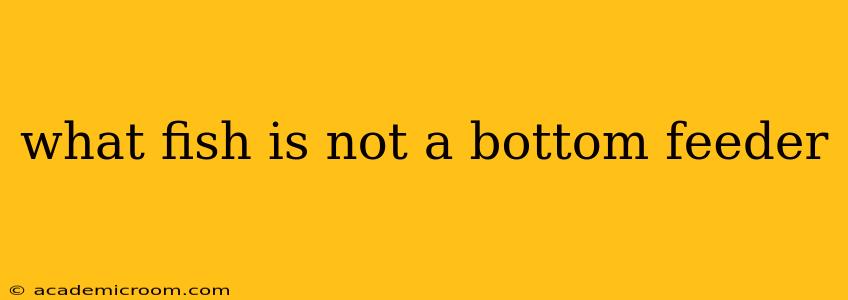What Fish is Not a Bottom Feeder? A Deep Dive into Fish Habitats and Feeding Habits
Many fish species are known for their bottom-feeding habits, scavenging for scraps and invertebrates on the seabed. However, a vast array of fish species inhabit various water columns and exhibit diverse feeding strategies. This article explores what defines a bottom feeder and showcases numerous fish species that are decidedly not bottom dwellers.
What exactly is a bottom feeder?
Before identifying fish that aren't bottom feeders, let's clarify the term. A bottom feeder, or benthic feeder, is a fish that primarily forages for food on or near the bottom of a body of water. Their diet often consists of benthic organisms like crustaceans, worms, mollusks, and decaying organic matter. Their physical adaptations, such as downward-facing mouths and flattened bodies, often reflect this lifestyle.
What are some examples of fish that are bottom feeders?
To better understand the contrast, let's briefly mention some common bottom-feeding fish:
- Catfish: Many catfish species are well-known bottom feeders, using their barbels (whiskers) to locate food in murky waters.
- Flounder: These flatfish lie camouflaged on the seabed, ambushing prey from below.
- Goby: Numerous goby species are benthic feeders, inhabiting various bottom habitats.
- Suckermouth Catfish (Plecostomus): Popular aquarium fish, these are known for their algae-eating habits, scraping surfaces in the tank bottom.
So, what fish are NOT bottom feeders?
Numerous fish species actively avoid the bottom and instead thrive in other parts of the water column. Their feeding strategies and adaptations reflect this. Here are some examples categorized by their preferred feeding zones:
Mid-water column feeders:
- Tuna: These pelagic fish are powerful swimmers that hunt in open water, feeding on smaller fish and squid.
- Salmon: These anadromous fish spend much of their lives in open ocean waters, feeding on smaller fish and crustaceans.
- Herring: These schooling fish feed on plankton and small organisms in the midwater.
- Cod: While some cod may feed near the bottom at times, they are primarily midwater predators, hunting fish and invertebrates in the water column.
Surface feeders:
- Flying fish: These remarkable fish use their large pectoral fins to glide above the water's surface, escaping predators and feeding on surface insects and plankton.
- Halfbeaks: These small fish often feed on the surface, picking off insects and other organisms.
Pelagic feeders:
- Sharks: Many shark species are pelagic predators, roaming vast expanses of open ocean in search of prey.
- Swordfish: These large, migratory fish hunt squid and other fish in the open ocean.
Reef dwellers (with varied feeding strategies):
Many reef fish aren't solely bottom feeders. Their diets can be incredibly diverse, depending on the species. Some may graze on algae (parrotfish), while others actively hunt small fish or invertebrates in the coral structures. Examples include:
- Angelfish: Some species are herbivores, others are carnivores.
- Butterflyfish: Many are specialized herbivores or carnivores.
- Damselfish: These often exhibit a combination of grazing and predatory habits.
Are there fish that sometimes feed at the bottom, but not exclusively?
Yes, many fish are opportunistic feeders. While they might primarily feed in the mid-water column or near the surface, they may occasionally forage on the bottom if suitable food is available. This behavior is not exclusive to any particular species but can vary based on individual fish, available food sources, and environmental conditions.
This illustrates that classifying a fish simply as a "bottom feeder" oversimplifies the complexity of aquatic ecosystems and the diverse feeding strategies of different fish species. Understanding these variations offers valuable insights into the intricate relationships within aquatic habitats.
